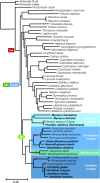Genetically encodable bioluminescent system from fungi
- PMID: 30478037
- PMCID: PMC6294908
- DOI: 10.1073/pnas.1803615115
Genetically encodable bioluminescent system from fungi
Abstract
Bioluminescence is found across the entire tree of life, conferring a spectacular set of visually oriented functions from attracting mates to scaring off predators. Half a dozen different luciferins, molecules that emit light when enzymatically oxidized, are known. However, just one biochemical pathway for luciferin biosynthesis has been described in full, which is found only in bacteria. Here, we report identification of the fungal luciferase and three other key enzymes that together form the biosynthetic cycle of the fungal luciferin from caffeic acid, a simple and widespread metabolite. Introduction of the identified genes into the genome of the yeast Pichia pastoris along with caffeic acid biosynthesis genes resulted in a strain that is autoluminescent in standard media. We analyzed evolution of the enzymes of the luciferin biosynthesis cycle and found that fungal bioluminescence emerged through a series of events that included two independent gene duplications. The retention of the duplicated enzymes of the luciferin pathway in nonluminescent fungi shows that the gene duplication was followed by functional sequence divergence of enzymes of at least one gene in the biosynthetic pathway and suggests that the evolution of fungal bioluminescence proceeded through several closely related stepping stone nonluminescent biochemical reactions with adaptive roles. The availability of a complete eukaryotic luciferin biosynthesis pathway provides several applications in biomedicine and bioengineering.
Keywords: bioluminescence; fungal luciferase; fungal luciferin biosynthesis.
Copyright © 2018 the Author(s). Published by PNAS.
Conflict of interest statement
Conflict of interest statement: K.S.S. and I.V.Y. are shareholders of Planta LLC. Planta LLC filed patent applications related to the use of the enzymes of fungal bioluminescent system.
Figures



References
-
- Shimomura O. Bioluminescence: Chemical Principles and Methods. World Scientific; Singapore: 2006.
-
- Wainwright PC, Longo SJ. Functional innovations and the conquest of the oceans by Acanthomorph fishes. Curr Biol. 2017;27:R550–R557. - PubMed
-
- Verdes A, Gruber DF. Glowing worms: Biological, chemical, and functional diversity of bioluminescent annelids. Integr Comp Biol. 2017;57:18–32. - PubMed
-
- Labella AM, Arahal DR, Castro D, Lemos ML, Borrego JJ. Revisiting the genus photobacterium: Taxonomy, ecology and pathogenesis. Int Microbiol. 2017;20:1–10. - PubMed
-
- Thouand G, Marks R. Bioluminescence: Fundamentals and Applications in Biotechnology. Springer; Berlin: 2016.
Publication types
MeSH terms
Substances
Grants and funding
LinkOut - more resources
Full Text Sources
Other Literature Sources
Medical

